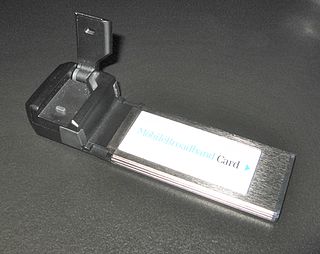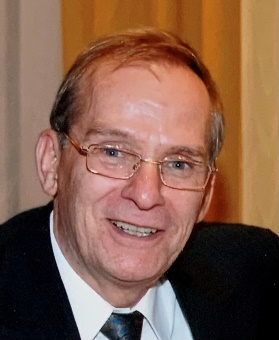Related Research Articles
4G is the fourth generation of broadband cellular network technology, succeeding 3G and preceding 5G. A 4G system must provide capabilities defined by ITU in IMT Advanced. Potential and current applications include amended mobile web access, IP telephony, gaming services, high-definition mobile TV, video conferencing, and 3D television.
Dedicated short-range communications (DSRC) is a technology for direct wireless exchange of vehicle-to-everything (V2X) and other intelligent transportation systems (ITS) data between vehicles, other road users, and roadside infrastructure. DSRC, which can be used for both one- and two-way data exchanges, uses channels in the licensed 5.9 GHz band. DSRC is based on IEEE 802.11p.
IEEE 802.11p is an approved amendment to the IEEE 802.11 standard to add wireless access in vehicular environments (WAVE), a vehicular communication system. It defines enhancements to 802.11 required to support intelligent transportation systems (ITS) applications. This includes data exchange between high-speed vehicles and between the vehicles and the roadside infrastructure, so called vehicle-to-everything (V2X) communication, in the licensed ITS band of 5.9 GHz (5.85–5.925 GHz). IEEE 1609 is a higher layer standard based on the IEEE 802.11p. It is also the basis of a European standard for vehicular communication known as ETSI ITS-G5.
Vehicular communication systems are computer networks in which vehicles and roadside units are the communicating nodes, providing each other with information, such as safety warnings and traffic information. They can be effective in avoiding accidents and traffic congestion. Both types of nodes are dedicated short-range communications (DSRC) devices. DSRC works in 5.9 GHz band with bandwidth of 75 MHz and approximate range of 300 metres (980 ft). Vehicular communications is usually developed as a part of intelligent transportation systems (ITS).
Vehicular ad hoc networks (VANETs) are created by applying the principles of mobile ad hoc networks (MANETs) – the spontaneous creation of a wireless network of mobile devices – to the domain of vehicles. VANETs were first mentioned and introduced in 2001 under "car-to-car ad-hoc mobile communication and networking" applications, where networks can be formed and information can be relayed among cars. It was shown that vehicle-to-vehicle and vehicle-to-roadside communications architectures will co-exist in VANETs to provide road safety, navigation, and other roadside services. VANETs are a key part of the intelligent transportation systems (ITS) framework. Sometimes, VANETs are referred as Intelligent Transportation Networks. They are understood as having evolved into a broader "Internet of vehicles". which itself is expected to ultimately evolve into an "Internet of autonomous vehicles".

Mobile broadband is the marketing term for wireless Internet access via mobile networks. Access to the network can be made through a portable modem, wireless modem, or a tablet/smartphone or other mobile device. The first wireless Internet access became available in 1991 as part of the second generation (2G) of mobile phone technology. Higher speeds became available in 2001 and 2006 as part of the third (3G) and fourth (4G) generations. In 2011, 90% of the world's population lived in areas with 2G coverage, while 45% lived in areas with 2G and 3G coverage. Mobile broadband uses the spectrum of 225 MHz to 3700 MHz.
Communications access for land mobiles (CALM) is an initiative by the ISO TC 204/Working Group 16 to define a set of wireless communication protocols and air interfaces for a variety of communication scenarios spanning multiple modes of communications and multiple methods of transmissions in Intelligent Transportation System (ITS). The CALM architecture is based on an IPv6 convergence layer that decouples applications from the communication infrastructure. A standardized set of air interface protocols is provided for the best use of resources available for short, medium and long-range, safety critical communications, using one or more of several media, with multipoint (mesh) transfer.

In telecommunications, 5G is the fifth-generation technology standard for cellular networks, which cellular phone companies began deploying worldwide in 2019, and is the successor to 4G technology that provides connectivity to most current mobile phones.
A connected car is a car that can communicate bidirectionally with other systems outside of the car. This connectivity can be used to provide services to passengers or to support or enhance self-driving functionality. For safety-critical applications, it is anticipated that cars will also be connected using dedicated short-range communications (DSRC) or cellular radios, operating in the FCC-granted 5.9 GHz band with very low latency.
The Cooperative Adaptive Cruise Control (CACC) is an extension to the adaptive cruise control (ACC) concept using Vehicle-to-Everything (V2X) communication. CACC realises longitudinal automated vehicle control. In addition to the feedback loop used in the ACC, which uses Radar, Camera and/or LIDAR measurements to derive the range to the vehicle in front, the preceding vehicle's acceleration is used in a feed-forward loop. The preceding vehicle's acceleration is obtained from the Cooperative Awareness Messages it transmits using ETSI ITS-G5, DSRC / WAVE technology or LTE-V2X PC5 interface as part of the C-V2X technology. Generally, these messages are transmitted several times per second by future vehicles equipped with ITS capabilities.
The first smart antennas were developed for military communications and intelligence gathering. The growth of cellular telephone in the 1980s attracted interest in commercial applications. The upgrade to digital radio technology in the mobile phone, indoor wireless network, and satellite broadcasting industries created new opportunities for smart antennas in the 1990s, culminating in the development of the MIMO technology used in 4G wireless networks.

Bernhard H. Walke is a pioneer of mobile Internet access and professor emeritus at RWTH Aachen University in Germany. He is a driver of wireless and mobile 2G to 5G cellular radio networks technologies. In 1985, he proposed a local cellular radio network comprising technologies in use today in 2G, 4G and discussed for 5G systems. For example, self-organization of a radio mesh network, integration of circuit- and packet switching, de-centralized radio resource control, TDMA/spread spectrum data transmission, antenna beam steering, spatial beam multiplexing, interference coordination, S-Aloha based multiple access and demand assigned traffic channels, mobile broadband transmission using mm-waves, and multi-hop communication.
A low-power, wide-area network is a type of wireless telecommunication wide area network designed to allow long-range communication at a low bit rate between IoT devices, such as sensors operated on a battery.

Vehicle-to-everything (V2X) is communication between a vehicle and any entity that may affect, or may be affected by, the vehicle. It is a vehicular communication system that incorporates other more specific types of communication as V2I (vehicle-to-infrastructure), V2N (vehicle-to-network), V2V (vehicle-to-vehicle), V2P (vehicle-to-pedestrian), V2D (vehicle-to-device).
Networked flying platforms (NFPs) are unmanned flying platforms of various types including unmanned aerial vehicles (UAVs), drones, tethered balloon and high-altitude/medium-altitude/low-altitude platforms (HAPs/MAPs/LAPs) carrying RF/mmWave/FSO payload (transceivers) along with an extended battery life capabilities, and are floating or moving in the air at a quasi-stationary positions with the ability to move horizontally and vertically to offer 5G and beyond 5G (B5G) cellular networks and network support services.
The 5G Automotive Association (5GAA) is a corporate coalition to develop and promote standardized protocols for automotive vehicles utilizing 5G communications. It serves as a lobbying group for the European Union on behalf of its membership. Their interests are government investments in the widespread deployment of short-range 5G wireless technology dubbed Cellular V2X.
RF CMOS is a metal–oxide–semiconductor (MOS) integrated circuit (IC) technology that integrates radio-frequency (RF), analog and digital electronics on a mixed-signal CMOS RF circuit chip. It is widely used in modern wireless telecommunications, such as cellular networks, Bluetooth, Wi-Fi, GPS receivers, broadcasting, vehicular communication systems, and the radio transceivers in all modern mobile phones and wireless networking devices. RF CMOS technology was pioneered by Pakistani engineer Asad Ali Abidi at UCLA during the late 1980s to early 1990s, and helped bring about the wireless revolution with the introduction of digital signal processing in wireless communications. The development and design of RF CMOS devices was enabled by van der Ziel's FET RF noise model, which was published in the early 1960s and remained largely forgotten until the 1990s.

An Aerial base station (ABS), also known as unmanned aerial vehicle (UAV)-mounted base station (BS), is a flying antenna system that works as a hub between the backhaul network and the access network. If more than one ABS is involved in such a relaying mechanism the so-called fly ad-hoc network (FANET) is established. FANETs are an aerial form of wireless ad hoc networks (WANET)s or mobile ad hoc networks (MANET)s.
In telecommunications, 6G is the designation for a future technical standard of a sixth-generation technology for wireless communications.
References
- 1 2 "Cellular V2X as the Essential Enabler of Superior Global Connected Transportation Services". IEEE 5G Tech Focus. 1 (2). IEEE. June 2017.
- ↑ Zhong, Ziyi; Cordova, Lauren; Halverson, Matthew; Leonard, Blaine. "Field Tests On DSRC And C-V2X Range Of Reception". Utah Department of Transportation . Archived from the original on 2022-11-28. Retrieved 2022-08-23.
- ↑ Mark Patrick, Benjamin Kirchbeck (January 27, 2018). "V2X-Kommunikation: LTE vs. DSRC" (in German).
- 1 2 GSA: C-V2X Market Report (retrieved 15 October 2019)
- ↑ Capacity: EU ambassadors reject ‘Wifi-only’ move for autonomous cars (4 July 2019)
- ↑ Eggerton, John (November 25, 2019). "FCC to split up 5.9 GHZ". Broadcasting & Cable : 20.
- ↑ "FCC Modernizes 5.9 GHz Band to Improve Wi-Fi and Automotive Safety". Federal Communications Commission. 2020-11-18. Retrieved 2022-04-27.
- 1 2 "Autonomous and connected vehicles: navigating the legal issues" (PDF). Archived from the original (PDF) on 2018-08-20. Retrieved 2018-08-20.
- ↑ JJ Anaya, P Merdrignac, O Shagdar (17 July 2014). "Vehicle to pedestrian communications for protection of vulnerable road users". 2014 IEEE Intelligent Vehicles Symposium Proceedings (PDF). pp. 1037–1042. doi:10.1109/IVS.2014.6856553. ISBN 978-1-4799-3638-0. S2CID 9647051.
{{cite book}}: CS1 maint: multiple names: authors list (link) doi : 10.1109/IVS.2014.6856553 - ↑ Toghi, Behrad; Saifuddin, Md; Fallah, Yaser; Hossein, Nourkhiz Mahjoub; M O, Mughal; Jayanthi, Rao; Sushanta, Das (5–7 December 2018). "Multiple Access in Cellular V2X: Performance Analysis in Highly Congested Vehicular Networks". 2018 IEEE Vehicular Networking Conference (VNC). pp. 1–8. arXiv: 1809.02678 . Bibcode:2018arXiv180902678T. doi:10.1109/VNC.2018.8628416. ISBN 978-1-5386-9428-2. S2CID 52185034.
- ↑ Hong-Chuan Yang, Mohamed-Slim Alouini (24 May 2018). "Wireless Transmission of Big Data: Data-Oriented Performance Limits and Their Applications". arXiv: 1805.09923 [eess.SP].
- ↑ Patrick Nelson (December 7, 2016). "Just one autonomous car will use 4,000GB of data per day". Network World.
- ↑ Gil Press. "6 Ways To Make Smart Cities Future-Proof Cybersecurity Cities". Forbes .
- ↑ "Tall structures and their impact on broadcast and other wireless services" (PDF).
- ↑ "5G-Netzausbau wird "unfassbar teuer"" (in German).
- ↑ Suhasini Gadam (2019-01-12). "Artificial Intelligence and Autonomous Vehicles".
- ↑ "Neuromorphic computing meets the automotive world". Design&Test. October 30, 2017.
- ↑ "How will AI, Machine Learning and advanced algorithms impact our lives, our jobs and the economy?". Harvard Business.
- ↑ "Weltkonzerne freuen sich über Meilenstein auf Lausitzring" (in German). April 18, 2019. Retrieved April 20, 2019.